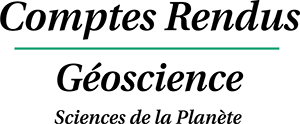In a recent paper, Khomsi et al. [6], using subsurface data, describe very nice structures buried beneath the Kairouan–Sahel Quaternary plain (Tunisia). The presented data are important because, after more general studies of the Tertiary geodynamic evolution of western Mediterranean [3,9,12], they confirm the existence of large inversion structures of Tertiary age south of the ‘South Atlas Front’ (SAF), a major tectonic boundary, running from Agadir (Morocco) to Tunis (Tunisia), which forms the southern limit of the Atlas system s.s. (see review in [4]). Some of these structures (‘chaînes des Chotts’ in Tunisia, Ougarta range in Algeria or Anti-Atlas in Morocco) have a morphologic expression and are consequently known since a long time. The discovery of Khomsi et al. [6] shows that the pattern is more general and suggests that numerous other blind structures could exist at a certain distance from the SAF. In fact, some of them are already known as the Guerguet–Melrhir oil/gas field in eastern Algeria [1].
Another aspect of the paper concerns the inversion process that took place since Late Cretaceous until Recent in the frame of the convergence between the European and African plates. On the seismic line presented by Khomsi et al. [6], the occurrence of numerous unconformities indicates alternation between periods of intense tectonic activity and periods of relative tectonic quiescence. The active periods are clearly indicative of strong coupling between the two plates. However, for chronological reasons (they predate the collision of the Tell–Rif internal domain with the African margin), it is established that they are not collision-related (see review in [2,4]). So, further work is required to completely understand their geodynamic significance.
The last point is more controversial. The authors permanently refer to major strike-slip faulting associated with the building of the Atlas Mountains. This concept is recurrent in the French literature since the seventies [8]. It is certain that in Early Mesozoic there was in North Africa a transform boundary with related transtensional basins such as the Atlas basins of Morocco, Algeria and Tunisia [7,8,13]. However, I do not share the opinion of many colleagues for major strike-slip faulting associated with the building of the Atlas Mountains themselves. On the contrary, field as well as subsurface observations [1,2,4,5,10,11,14,15], including the cross-section presented by Khomsi et al. [6], rather suggest that reverse faulting was the main mechanism active during the inversion of the Atlas basins. It seems to me that a good compromise would be to conceive the Atlas as a previous transtensional system subsequently inverted as a fold-and-thrust belt. During the Quaternary, some oblique-slip displacements are possible, in particular along the so-called north–south axis of Tunisia, but the active tectonics of North Africa remains dominated by thrust faulting.


